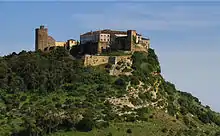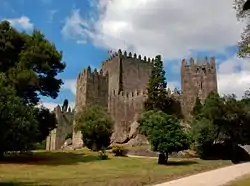Castle of São Ramão
The Castle of São Ramão (Portuguese: Castelo de São Ramão) is a medieval castle located in the civil parish of Viade de Baixo e Fervidelas, in the municipality of Montalegre, Portuguese district of Vila Real.
| Castle of São Ramão | |
|---|---|
Castelo de São Ramão | |
| Vila Real, Alto Trás-os-Montes, Norte Region, Portugal in Portugal | |
| Type | Castle |
| Site information | |
| Owner | Portuguese Republic |
| Operator | DRCPorto |
| Open to the public | Public |
| Site history | |
| Materials | Granite, Mortar |
History
During the 1258 Inquiries, the site of was identifiable with the royal properties of São Romanus.[1]
In the 1758 Parochial Memories, it was part of Parafita, falling within the limits of the municipality of Montalegre.[1][2] At that time, the then-ruins were referred to as "an impregnable and ancient castle".[1] Father Baltazar Pereira Barroso, agreeing with the description, affirmed that the castle had its base in a Roman construction, substantiated by the vestiges of five Roman road that connected it to Braga.[1][2] Continuing, he indicated the ruins were fabricated by people of "intelligence", and not by barbarians (suggesting the Moors), noting a painted calf idol constructed by Romans nearby.[1] But, local residents from Veade, in search of treasures, demolished many of the memorable structures, including the calf and part of the cistern that existed at the heights of the castle.[1] Half a league from the western wall near one of the Roman roads were the ruins of a fortification once referred to as the Castle of D. Rodrigo, where two farmers had built their homes on Roman foundations and parts of the walls; by 1758, there were still remnants of the Castle of São Romão and D. Rodrigo.[1][2]
The firsts to preserve the remnants began on 16 November 1973. At that time, the Junta Nacional de Educação (National Junta for Education) proposed the classification of the castle a Property of Public Interest.[1] This was superseded on 6 March 2006, by the DRPorto, which proposed the establishment of a Special Protection Zone for the property, leading to the classification of the property as a Sítio de Interesse Público and incorporating it into its own Special Protection Zone on 10 January 2014 (Diário da República, Série 2, 7, Ordinance 20/2014).[1]
Architecture
The site is situated on a rural, isolated hilltop covered in gorse and undergrowth, marked by a difficult access and overlooking the Rabagão River.[1][2]
The rocky castle was circled by a line of walls with the settlement excavated into outcrop and constructed with large ashlar stone.[1] At the top of the hill are the vestiges of a tower and cistern, whose walls are carved into the stone or constructed of granite and mortar, 3.3 by 2.5 by 1.3 metres (10.8 ft × 8.2 ft × 4.3 ft).[1][2]
On the eastern, western and southern platforms are the visible foundations of residential structures built with large ashlar stone.[1]
Artefacts from the archaeological dig include fragments of medieval pottery, numismatic elements, grindstones and half-round roofing tile.[1]
References
Notes
- Sereno, Isabel; Amaral, Paulo; Noé, Paula (2004), SIPA (ed.), Castelo de São Romão/Castro de São Romão/Alto do Castelo (IPA.00005810/PT011706340008) (in Portuguese), Lisbon, Portugal: SIPA – Sistema de Informação para o Património Arquitectónico, archived from the original on 20 December 2016, retrieved 18 April 2016
- Vale, Ana (2013), Sítio Arqueológico do Castelo de São Romão, IGESPAR – Instituto de Gestão do Património Arquitectónico e Arqueológico (Portuguese Institute of Architectural and Archaeological Heritage), retrieved 31 March 2016
Sources
- Barreiros, Fernando Braga (1915), "Ensaio de inventário dos castros do concelho de Montalegre", O Arqueólogo Português (in Portuguese) (20 ed.), Lisbon, Portugal, p. 212
{{citation}}: CS1 maint: location missing publisher (link) - Barrieros, Fernando Braga (1919), "Materiais para a arqueologia do concelho de Montalegre", O Arqueólogo Português (in Portuguese) (24 ed.), Lisbon, Portugal, p. 73
{{citation}}: CS1 maint: location missing publisher (link) - Costa, João Gonçalves da (1968), Montalegre e Terras de Barroso (in Portuguese), Montalegre, Portugal, p. 41
{{citation}}: CS1 maint: location missing publisher (link) - Fontes, António Lourenço (1978), Comemorações do Milenário de S. Rosendo (in Portuguese), Montalegre, Portugal, pp. 13–33
{{citation}}: CS1 maint: location missing publisher (link) - Borges, José G. Galvão (1 June 2000), "Montalegre no Dicionário Geográfico", Revista Aquae Flaviae (in Portuguese), Chaves, Portugal, pp. 63–78
{{citation}}: CS1 maint: location missing publisher (link)


